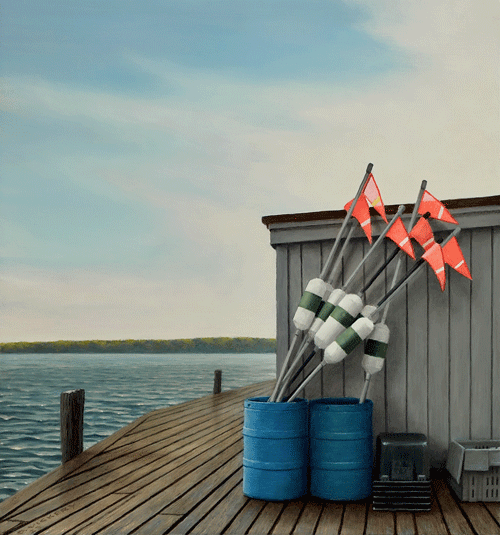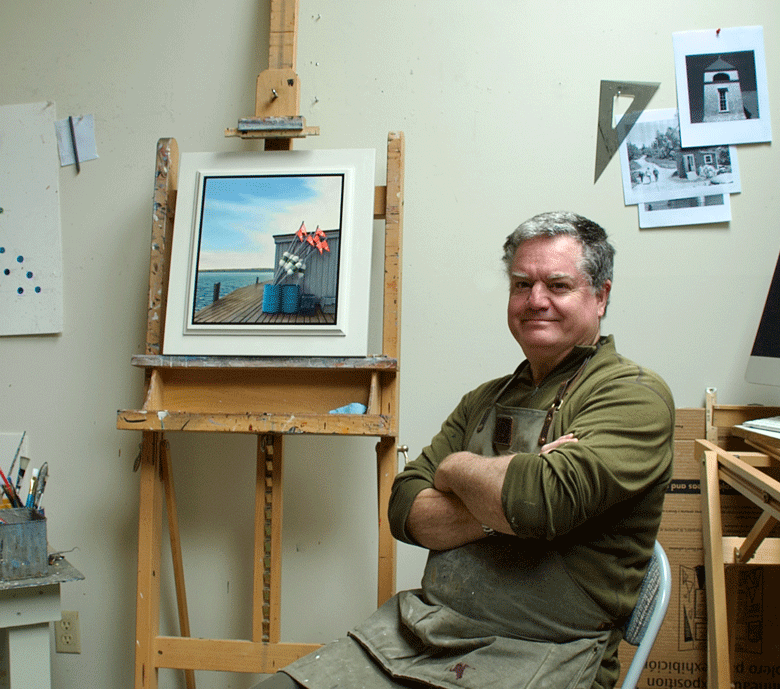In an Instagram post in early June, painter David Vickery shared a recent painting, “Flag Buoys, Olson Wharf,” accompanied by this cursory description: “Down at the end of my road, where there’s usually something interesting.”
Vickery lives on a lane off Hathorne Point Road in Cushing, a quarter mile from the wharf, and he often walks down there after dinner.
“Being a working dock, fishing gear is always coming and going, and the weather, tide, and light are always different,” he reports.
This particular time he noticed the buoys “casually stuck” in bait barrels. Attracted to their “eye-catching” Day-Glo flags, he liked “the sense of anticipation of their career in the ocean, where I imagine they are now.”
Asked about these buoys, Vickery’s lobsterman neighbor told him they’re called “high flyers.” They mark the ends of trap lines, thereby offering better visibility to other fishermen, so they don’t “set over each other’s gear.”
“Being a working dock, fishing gear is always coming and going…”
Vickery finds many of the subjects for his realist paintings close to home, “generally things that have depth and meaning because they’re familiar,” he writes, adding, “I have a sense of their history, and I’m better able to see them as metaphors.”
He likens finding a motif to dowsing, where “your intuition tells you there’s something meaningful there, even if you don’t always understand why.”
Vickery has painted other wharves, including the one on Monhegan which he first discovered as a Carina House artist-in-residence in 1993. Asked what appeals to him about the subject, he notes that they are transitional places and thus have a built-in dynamic of expectation, “and the sea beyond is always interesting and metaphoric.”

Olson Wharf sits on Maple Juice Cove, not far from the mouth of the St. George River to the south. The wharf gets its name from the Olson family of Andrew Wyeth fame. Vickery’s friend, lobsterman Sam Olson, owns the wharf. His grandfather, also named Sam, was Christina and Alvaro Olson’s brother.
Vickery remembers chatting with Sam’s father John, who died in 2019 at age 97. The painter was fascinated by John Olson’s stories of serving in the Navy during World War II, which included losing 24 shipmates during the Normandy invasion when a torpedo hit his destroyer and witnessing the Japanese surrender in Tokyo Bay.
Originally from Connecticut, Vickery first came to Maine in the late 1960s to visit his grandparents’ modest summer home on Islesboro and later camped with his family on the coast every summer. “From the age of about seven I knew I wanted to live in Maine,” he says.
In 1985 Vickery took a course at the Apprenticeshop, then in Rockport, thinking he might become a boat-builder, but art classes at College of the Atlantic hooked him on painting. In 1991, two years after graduating from COA, he moved to Cushing full-time and began his art career.
A fan of Hopper, Homer, the Wyeths, the Dutch and Northern Renaissance realists, and photographers like Eliot Porter, Paul Strand, and Paul Caponigro, Vickery found his muse in Maine. Today, he enjoys an ever-growing audience that admires—and acquires—his precise renderings of coastal scenes, be it the Red House on Monhegan, a clammer working an icy cove—or those bright flags flying over a humble wharf down the road a piece.
Vickery is represented by Dowling Walsh Gallery in Rockland and The Gallery at Somes Sound in Somesville. You can see more of his work on their websites as well as at www.dvickery.com.
Carl and David Little’s Art of Acadia comes out in a paperback edition this summer.





